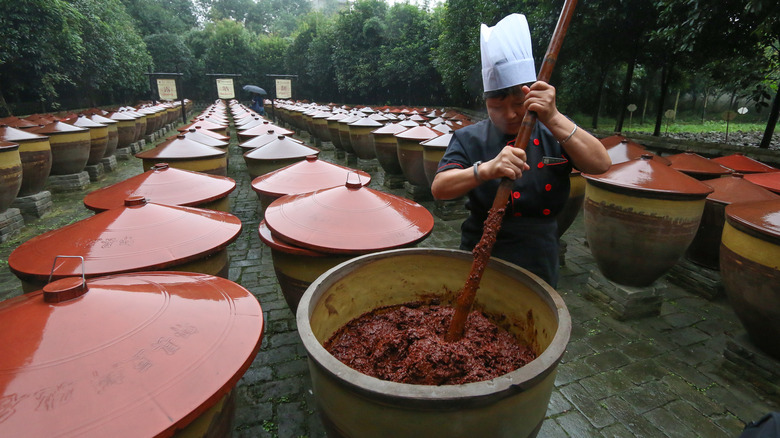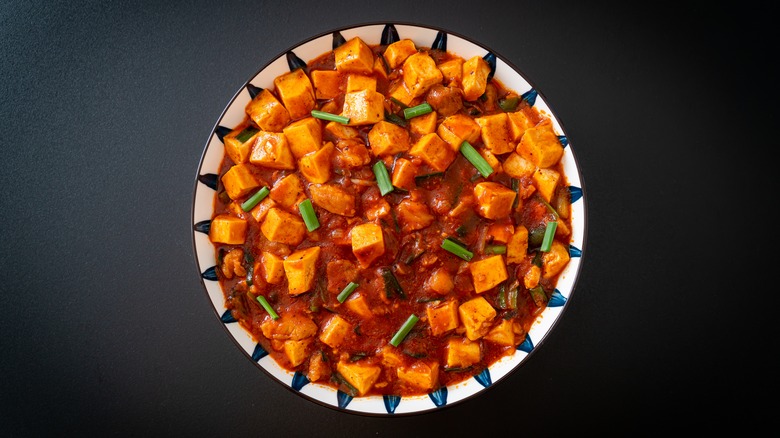The Ancient Fermented Chili Spice Andrew Zimmern Treasures Most
When it comes to condiments, ketchup is tops according to American taste buds. A Zippia poll found that a whopping 25 states preferred ketchup to other types of condiments, with barbecue sauce coming in a distant second after being named the favorite in eight states. Other condiments featured on the poll have a lower profile, such as Utah's beloved fry sauce (which consists of two parts mayo to one part ketchup) and tartar sauce, which is praised by residents of Alaska and Montana. As for the rest of the world, condiment selection varies greatly among different countries and regions.
Take France, for instance, which can't get enough of its verjuice, which is fresh juice squeezed from unripe grapes. The flavor is similar to vinegar due to the high acid levels, which makes for a lip-puckering experience when verjuice is added to salads as dressing. In Japan, mirin is a type of rice wine that imparts a sweet flavor to recipes, such as grilled tofu and teriyaki. While all mirin contains alcohol, the actual content varies according to the variety, with hon mirin having the highest concentration. In addition to these worldly condiments, there are other selections that are even rarer and more intriguing. This was certainly the case when world-famous chef and television personality Andrew Zimmern shared his favorite condiments during an interview.
A precious condiment 25 years in the making
Most people know Andrew Zimmern from his hit TV show "Bizarre Foods." However, Zimmern has an expansive history as an award-winning chef, including being a four-time recipient of the coveted James Beard Award. Much of his career has been devoted to shining a light on lesser-known cuisines throughout the world, which he samples during his epic travels. It was during one such adventure that Zimmern became the proud owner of a very special condiment that he considers the prize of his collection.
During an interview with Lifehacker, Zimmern discussed some of the favorite condiments he keeps in his pantry. Among the many varieties of soy sauce, mustard, and vinegar the chef keeps on hand at home, he also has a selection of dou ban, a type of paste made with fermented beans and chili peppers that's quite popular in Sichuan cooking. Out of the eight types of dou ban in his kitchen, one was gifted to Zimmern by a fellow chef in Chengdu, China. This particular dou ban is over 25 years old and stored in a clay pot, with the chef musing "it'll last forever, right?" Even if you're not lucky enough to have such a prized commodity in your kitchen, the standard forms of the condiment can really liven up your recipes.
How to use dou ban when cooking at home
While you can enjoy dou ban (also known as doubanjiang) when eating at your favorite Sichuan restaurant, the condiment can also be efficiently incorporated into home cooking with the right approach. Because doubanjiang is a little overpowering when too much is used, it should be added to recipes carefully. It's often most effective when fried with other ingredients in hot oil to temper its flavor, at which point it can be combined with other foods, such as noodles.
In terms of where to find this tasty condiment, your best bet is your local Chinese grocer. If possible, try to find a brand that originated in Pixian County, Chengdu, as this area is considered among the best when it comes to doubanjiang producers. Also, take a moment to look at the ingredients and avoid products with a lot of additives and artificial components. A quality doubanjiang will only contain chilies, wheat flour, broad beans, and salt. After opening, it's best to store the remaining doubanjiang in a refrigerator, where it can last months in a jar with a sealable lid. While it probably won't last a quarter of a century, proper storage of doubanjiang ensures you get to enjoy every bit of this spirited condiment.


